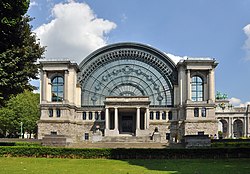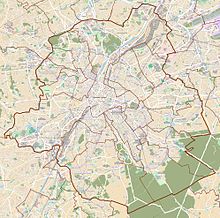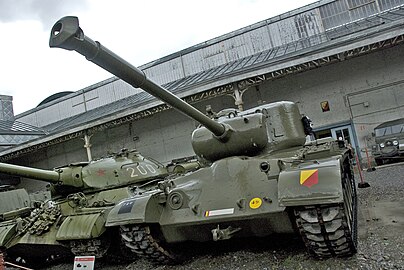Royal Museum of the Armed Forces and Military History
This article needs additional citations for verification. (November 2010) |
 The entrance to the northern Bordiau hall | |
 Location within Brussels | |
| Established | June 28, 1923[1] |
|---|---|
| Location | Cinquantenaire Park 3 Brussels B-1000 Belgium |
| Coordinates | 50°50′26″N 4°23′34″E / 50.84046°N 4.392833°E |
| Type | Military Museum |
| Public transit access | Schuman and Merode |
| Nearest car park | Museum grounds |
| Website | Official website |
The Royal Museum of the Armed Forces and Military History (French: Musée Royal de l’Armée et d’Histoire Militaire, often abbreviated to MRA, Dutch: Koninklijk Museum van het Leger en de Krijgsgeschiedenis, KLM) is a military museum that occupies the two northernmost halls of the historic complex in Cinquantenaire Park in Brussels, Belgium.[2] The park is set on the continuation of Rue de la Loi/Wetstraat, which starts at the end of Brussels' Park before the Royal Palace.
History[]
At the Brussels International Exposition of 1910, a section on military history was presented to the public and met with great success. Given the enthusiasm of the population, the authorities created a military museum within the international context of extreme tension which led to the Great War.[clarification needed] The museum was originally installed on the site of La Cambre Abbey and moved to the Cinquantenaire Park in 1923.
The building[]
In 1875, the Belgian architect Gédéon Bordiau made a proposal to build flats on the site of a former parade ground of the Garde Civique. The location was named Cinquantenaire in French (literally "50th anniversary") because it was planned as an exhibition space to celebrate the half-century since Belgium's independence in 1830.[1]
Temporary structures were erected on the site for the International Exposition of 1897 as Bordiau's work had not been finished.[1] The construction of buildings was put on hold in 1890 for lack of funds and was eventually stopped by the death of the architect in 1904. Work resumed the following year under the direction of French architect Charles Girault and was completed with a new patron, King Leopold II. The triumphal arch that had already been planned was amended and expanded to meet the wishes of the King.
A fire destroyed the south wing of the building in 1946, part of the Royal Museums of Art and History. The collection pieces were saved, and the burnt wing has since been rebuilt. As for the north wing, home to the Royal Museum of the Armed Forces and Military History, it was spared.
Collection[]

The museum's collection originally consisted of approximately 900 pieces collected by the officer Louis Leconte following the Great War.[citation needed] Leconte collected considerable equipment abandoned by the Germans in 1918. The collection was later heavily enriched by legacies, gifts and exchanges.
Important developments include the opening of the armour section (1980), the move of the armour collection from the northernmost hall (1986), and the opening of the marine section (1996). Today, the museum displays uniforms, weapons, vehicles and military equipment of all ages and all countries.
Aviation hall[]
The north wing, built by Gideon Bordiau, has been occupied by the aviation hall since 1972 when the Air and Space gallery was inaugurated.[citation needed] The collection includes various types of aircraft, both military and civilian, some dating back to the early 20th century. It includes surviving First World War aircraft like the Nieuport 17 and Sopwith Camel, while the most recent additions include an F-16 Fighting Falcon and Westland Sea King.
Gallery[]

Historic armors

Portrait of Anne François Mellinet (c. 1815, attributed to Jacques-Louis David)

Belgian and French warships during the Rio Nuñez Incident, Paul Jean Clays, c. 1850

Portrait of Lieutenant at sea, 1st class Guillaume Delcourt by Louis Joseph Ghémar (Lithography, 1854)[3]

A part of the collection contains historic medals
Main gallery of the museum, displaying the collection of Belgian 19th-century militaria

M46 Patton tank in the Museum's outdoor collection

Belgian 1970s' Paracommando diorama
See also[]
References[]
- ^ Jump up to: a b c "The history of the museum". Klm-mra.be. Archived from the original on 3 June 2013. Retrieved 25 March 2013.
- ^ "Royal Museum of the Armed Forces and of Military History". Away.com.
- ^ Louis Leconte, « Les ancêtres de notre Force Navale », Bruxelles, 1952, p. 186.
External links[]
| Wikimedia Commons has media related to Royal Military Museum, Brussels. |
- Museums established in 1923
- Military and war museums in Belgium
- Museums in Brussels
- Aerospace museums
- Tank museums
- Cinquantenaire
- 1923 establishments in Belgium
- Organisations based in Belgium with royal patronage








